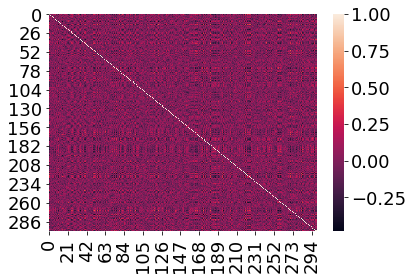Using timecorr¶
timecorr is used to approximate dynamic high-order correlations.
There are two steps to timecorr:
- Calculate dynamic correlations
- Dimensionally reduce back to the original size of the data
By repeating these steps, you can approximate higher-order correlations in a computationally tractable way. Although both of these steps can be accomplished in just a single, we’ll go through and break it down.
Load in required libraries¶
import timecorr as tc
import numpy as np
import seaborn as sns
import warnings
warnings.simplefilter("ignore")
%matplotlib inline
Simulate some data¶
First, we’ll use the built in simulation function to simulate some
timeseries. By default, the simulate_data function will return a 100
samples from 1 subject, using ramping data generation function with 10
features and 5 blocks, but you can specify the number of time samples
with T, the number of subjects with S, and number of features
with K. You can also set a random seed to get consistent results
across simulations. If you want further information on simulating data,
check out the simulate API page.
# simulate 1 subject's timeseries
sim_1 = tc.simulate_data(S=1, T=200, K=300, set_random_seed=100)
# output for 1 subject is an array
print('shape : ' + str(np.shape(sim_1)))
print('type : ' + str(type(sim_1)))
shape : (200, 300)
type : <class 'numpy.ndarray'>
# simulate 3 subjects' timeseries
sim_3 = tc.simulate_data(S=3, T=200, K=300, set_random_seed=100)
# output for 3 subjects is a list of arrays
print('shape : ' + str(np.shape(sim_3)))
print('type : ' + str(type(sim_3)))
print('type for sim_3[0] : ' + str(type(sim_3[0])))
shape : (3, 200, 300)
type : <class 'list'>
type for sim_3[0] : <class 'numpy.ndarray'>
Calculate dynamic correlations¶
Now that we have a list of arrays of simulated timeseries data, we can
start using timecorr. Let’s start by going over the way we calculate
dynamic correlations. We use a kernel based approach, and you can
specify but the type of kernel with weights_function and the width
with weights_params that you want to use to calculate the
correlations.
For this example, we’re going to use a gaussian kernel and a width of 5. Here’s how:
# specify kernel:
width = 5
gaussian = {'name': 'Gaussian', 'weights': tc.gaussian_weights, 'params': {'var': width}}
# calcuate the dynamic correlations use a gaussian kernel and width of 5 for 1 simulate subject
vec_corrs = tc.timecorr(sim_1, weights_function=gaussian['weights'], weights_params=gaussian['params'])
timecorr returns a vectorized version of the correlation matrices.
Specifically, the upper triangle of correlation matrices. If you want
the full correlation matrices, use the vec2mat function. Also,
mat2vec converts them back to the vectorized version.
# returns moment-by-moment correlations, but just the upper triangle for the matrices
print('vectorized shape : ' + str(np.shape(vec_corrs)))
# use the vec2mat function to convert vectorized correlations to moment-by-moment full correlations
mat_corrs = tc.vec2mat(vec_corrs)
# return the dynamic full correlations
print('matrix shape : ' + str(np.shape(mat_corrs)))
vectorized shape : (200, 45150)
matrix shape : (300, 300, 200)
Let’s plot one of these full correlation matrices.
sns.heatmap(mat_corrs[:, :, 100])
<matplotlib.axes._subplots.AxesSubplot at 0x116d1d518>

Ok let’s now calculate the dynamic correlations for for the 3 simulated
subjects. The default cfun calculates a continuous verison of
Inter-Subject Functional Connectivity (Simony et al. 2017). If only one
data array is passed (rather than a list), the default cfun returns the
moment-by-moment correlations for that array. The default for the
combine function is none, but for this example we’ll use
corrmean_combine which calcuates the average correlations across
matrices. For more information on the different function options, please
check out the API documenation.
# calcuate the dynamic isfc correlations use a Laplace kernel
# and width of 10 for 3 simulated subjects, and take the element-wise average correlations across matrices.
width = 10
laplace = {'name': 'Laplace', 'weights': tc.laplace_weights, 'params': {'scale': width}}
dyna_corrs = tc.timecorr(sim_3, combine=tc.corrmean_combine,
weights_function=laplace['weights'], weights_params=laplace['params'])
# again, this returns the vectorized version of the dynamic correlations
print('vectorized shape : ' + str(np.shape(dyna_corrs)))
vectorized shape : (200, 45150)
Higher order correlations¶
Ok, now that we’ve gone over how to calculate dynamic correlations,
let’s walk through reducing the correlations back to the original size
of the data using the rfun parameter. Again, you have several
options. If you want more information, please checkout the API
documentation.
The default for rfun is None, which we used for calculating the
dynamic correlations, but in this example we’ll use PCA.
# approximate the dynamic isfc correlation, using a Laplace kernel, width 10, and reducing using PCA
width = 10
laplace = {'name': 'Laplace', 'weights': tc.laplace_weights, 'params': {'scale': width}}
dyna_corrs_reduced = tc.timecorr(sim_3, rfun='PCA',
weights_function=laplace['weights'], weights_params=laplace['params'])
# this returns the approximated dynamic correlations the same size as the original data
print('original shape : ' + str(np.shape(sim_3)))
print('reduced shape : ' + str(np.shape(dyna_corrs_reduced)))
original shape : (3, 200, 300)
reduced shape : (3, 200, 300)
To calculate higher-order correlations, you can repeat this process up to any order you want. For example, if we want to calculate correlations up to the second order, we repeat this process twice.
order_0 = sim_3
order_1 = tc.timecorr(order_0, rfun='PCA', weights_function=laplace['weights'], weights_params=laplace['params'])
order_2 = tc.timecorr(order_1, rfun='PCA', weights_function=laplace['weights'], weights_params=laplace['params'])
Ok, and that’s it!